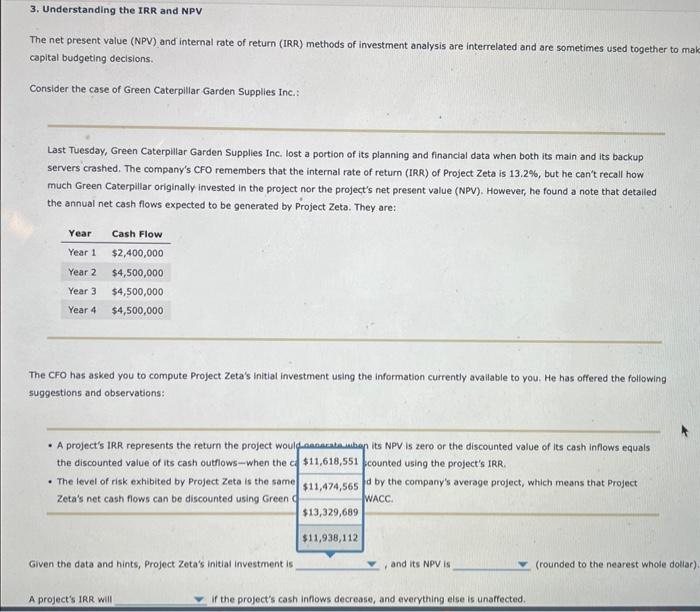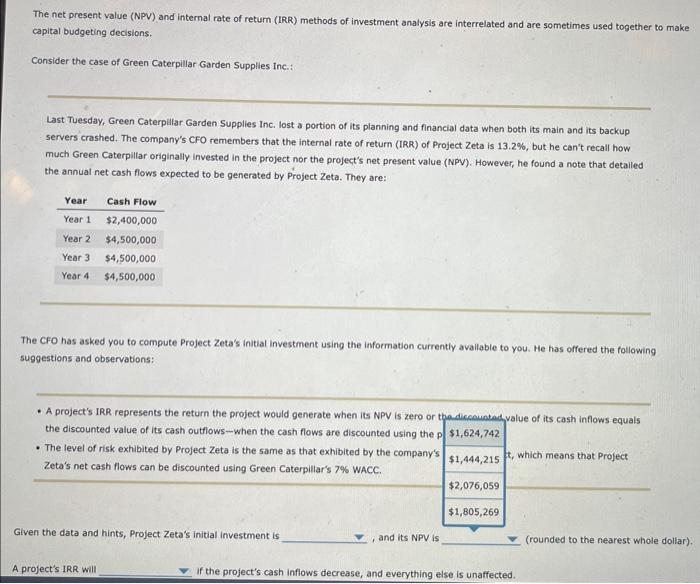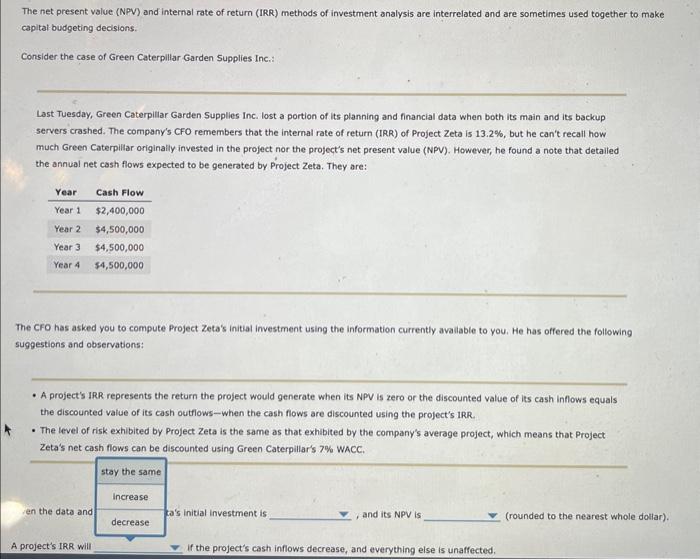3. Understanding the IRR and NPV The net present value (NPV) and internal rate of return (IRR) methods of investment analysis are interrelated and are sometimes used together to m capital budgeting decisions. Consider the case of Green Caterpillar Garden Supplies Inc.: Last Tuesday, Green Caterpillar Garden Supplies Inc. lost a portion of its planning and financial data when both its main and its backup servers crashed. The company's CFO remembers that the internal rate of return (IRR) of Project Zeta is 13.2%, but he can't recall how much Green Caterpillar originally invested in the project nor the project's net present value (NPV). However, he found a note that detalled the annual net cash flows expected to be generated by Project Zeta. They are: The Cro has asked you to compute Project Zeta's initial investment using the information currently avallable to you. He has offered the following suggestions and observations: - A project's IRR represents the return the project wouldinanaratawhop its NPV is zero or the discounted value of its cash inflows equals the discounted value of its cash outflows-when the c. $11,618,551 counted using the project's IRR. - The level of risk exhibited by Project Zeta is the same $11,474,565 d by the company's average project, which means that Project Zeta's net cash flows can be discounted using Green \begin{tabular}{l|l|} \hline$13,329,689 \\ $11,938,112 & \\ \hline , and its NPV is \\ (rounded to the nearest whole dolla \end{tabular} Given the data and hints, Project Zota's initial investment is A project's IRR will If the project's cash inflows decrease, and everything eise is unaffected. The net present value (NPV) and internal rate of return (IRR) methods of investment analysis are interrelated and are sometimes used together to make capital budgeting decisions. Consider the case of Green Caterpillar Garden Supplies Inc.: Last Tuesday, Green Caterpillar Garden Supplies Inc. lost a portion of its planning and financial data when both its main and its backup servers crashed. The company's CFO remembers that the internal rate of return (IRR) of Project Zeta is 13.2%, but he can't recall how much Green Caterpillar originally invested in the project nor the project's net present value (NPV). However, he found a note that detailed the annual net cash flows expected to be generated by Project Zeta. They are: The CFO has asked you to compute Project Zeta's initial investment using the information currently avallable to you. He has offered the following suggestions and observations: - A project's IRR represents the return the project would generate when its NPV is zero or tho dicoownots value of its cash inflows equals the discounted value of its cash outflows - when the cash flows are discounted using the p$1,624,742 - The level of risk exhibited by Project Zeta is the same as that exhibited by the company's $1,444,215, which means that Project Zeta's net cash flows can be discounted using Green Caterpillar's 7% WACC. Given the data and hints, Project Zeta's initial investment is and its NPV is (rounded to the nearest whole dollar) A project's IRR will If the project's cash inflows decrease, and everything else is unaffected. The net present value (NPV) and internal rate of return (IRR) methods of investment analysis are interrelated and are sometimes used together to make capital budgeting decisions. Consider the case of Green Caterpillar Garden Supplies Inc.: Last Tuesday, Green Caterpillar Garden Supplies Inc. lost a portion of its planning and financial data when both its main and its backup servers crashed. The company's CFO remembers that the internal rate of return (IRR) of Project Zeta is 13.2%, but he can't recail how much Green Caterpillar originally invested in the project nor the project's net present value (NPV). However, he found a note that detailed the annual net cash flows expected to be generated by Project Zeta. They are: The CFO has asked you to compute Project Zeta's initial investment using the information currently available to you. He has offered the following suggestions and observations: - A project's IRR represents the return the project would generate when its NPV is zero or the discounted value of its cash inflows equals the discounted value of its cash outflows - when the cash flows are discounted using the project's IRR. - The level of risk exhibited by Project Zeta is the same as that exhibited by the company's average project, which means that Project Zeta's net cash flows can be discounted using Green Caterpillar's 7\% WACC. een the data and a's initial investment is and its NPV is (rounded to the nearest whole dollar). A project's IRR will If the project's cash inflows decrease, and everything else is unaffected









